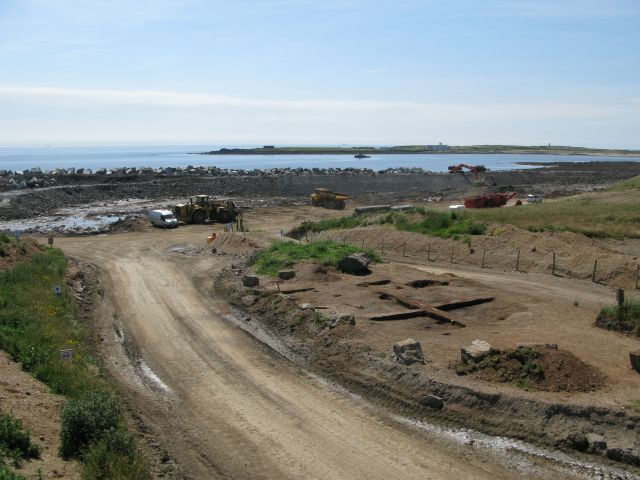In 2009, Oxford Archaeology North discovered a Mesolithic pit house at Ronaldsway Airport. This would have been a substantial building, comprising a sub-circular hollow, approximately 7m in diameter, containing a ring of postholes and an internal redeposited gravel platform opposing a north-facing entrance. Radiocarbon dating indicates that the house, named Cass ny Hawin II owing to its similarity and proximity to Cass ny Hawin, another Mesolithic house excavated by Peter Woodman in the 1980s, dates between c. 8200-7950 cal BC, and is 1000 years older than any other archaeological site presently known on Man.

The post-excavation analysis is now well under way, and the preliminary results are extremely encouraging. The house was 100% sampled and carefully excavated in spits. It contained large numbers of flaked lithics and coarse stone tools, as well as a rich assemblage of charred plant remains, including the probable remains of a hazel-wood floor. Finds were surveyed in three dimensions, with c. 14,000 struck flints being recovered this way. When environmental samples were floated, a further 8000 flints were retrieved, as well as over 10,000 hazelnut fragments. It appears that the remains were fossilised in situ when the house burnt down, so analysis should permit the spatial dynamics of the building to be understood – in other words, how it was lived in.
Charcoal assemblages were quantified spatially in order to determine the relative abundance of taxa present in each grid square. The data point to the restricted and selective use of woodland resources, with hazel and hawthorn-type (apple, whitebeam, hawthorn) wood being the main species used in the house construction, perhaps forming a frame for a skin covering. Existing pollen records from Man suggest that very few oak trees would have been present at the time when the house was occupied. However, some oak charcoal was present, concentrated towards the centre of the building, and it is possible that this indicates the location of a hearth. Supporting this interpretation, pits and other internal features surrounded this area, along with many of the coarse stone tools, and the flints and hazelnuts were also very densely concentrated in this location. One of these features, which contained a clutch of hammerstones, produced unusually high frequencies of willow/poplar charcoal, and may have been a carbonised basket. Other concentrations of hazelnuts occurred flanking the doorway, one within a stakehole-defined compartment, and these could have been caches of food.

The flints were much more frequent within the north-western quadrant of the house, and there is evidence that knapping took place there. There were also other marked differences in the distribution of lithic types, suggesting that different activities routinely took place in discrete parts of the building. The sharp flints do not seem to have been cleaned out and do not seem to have been a problem, presumably because they would have fallen through gaps in the hazel floor.
The lithic assemblage is narrow blade in character and scalene triangles are the dominant microlith form. This is true of assemblages from other similar houses dated to the same period that have only been found in eastern Scotland and north-eastern England (one at Howick being the most famous example). Clive Waddington, one of the excavators of Howick, has suggested that the houses, and associated lithic cultures, indicate migration of hunter gatherers westwards from Doggerland, as territory was lost due to rising sea levels. The discovery of Cass ny Hawin II suggests that other such houses might one day come to light in south-western Scotland and north-western England, and that the migrations reached further westwards rather earlier than was previously thought.
Source: Oxford Archaeology News


